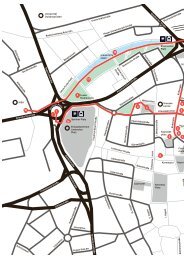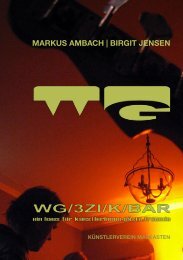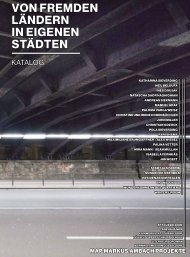B1|A40 THE BEAUTY OF THE GRAND ROAD
DIE SCHÖNHEIT DER GROSSEN STRASSE 2014 EINE AUSSTELLUNG IM STADTRAUM DER A40 VON DUISBURG BIS DORTMUND 14.06.2014 – 07.09.2014 MAP MARKUS AMBACH PROJEKTE URBANE KÜNSTE RUHR (HG.) WIENAND
DIE SCHÖNHEIT DER GROSSEN STRASSE 2014
EINE AUSSTELLUNG IM STADTRAUM DER A40 VON DUISBURG BIS DORTMUND
14.06.2014 – 07.09.2014
MAP MARKUS AMBACH PROJEKTE
URBANE KÜNSTE RUHR
(HG.)
WIENAND
You also want an ePaper? Increase the reach of your titles
YUMPU automatically turns print PDFs into web optimized ePapers that Google loves.
RECONSTRUCTING A LANDSCAPE At first<br />
glance, the district of Dortmund-Schönau does<br />
not embody any sort of problematic, questionable,<br />
or bizarre situation along the A40.<br />
Schönau is like an idyllic village of single-family<br />
homes and mansions. Its locale, in the hilly<br />
area just before the monumental Schnettker<br />
bridge, seems practically luxurious. Now, after<br />
being renovated, the bridge provides enough<br />
protection from the noise of the A40 to give the<br />
town – which, until recently, resembled a large<br />
construction site due to the construction traffic<br />
– a little bit of peace and quiet. In this nearly<br />
village-like idyll, the restored Emscher River<br />
and the Rüppingsbach wind their way past villas,<br />
gardens, and flood-meadows through Schönau,<br />
the Emscher Valley, and beneath the A40.<br />
Along a two-hour hiking trail, <strong>B1|A40</strong> questioned<br />
today’s notions of landscape. While some consider<br />
it the epitome of nature, land here has actually<br />
long been a cultivated landscape subject<br />
to the fashions of each era. 1 It articulates an omnipresent<br />
theme in a region with a significant<br />
history of exploiting natural resources – one<br />
that is currently in great need of renewal.<br />
The recently completed restoration of the Emscher<br />
here underscores this. During the postwar<br />
era, the economy demanded progress in<br />
the form of the straightest river possible, where<br />
water, clean or not, would flow as quickly as<br />
possible. This was especially true of the Emscher,<br />
which served as a sewage canal for the<br />
entire region, transporting poisonous industrial<br />
waste to the Rhine. Of course, it’s understandable<br />
that this concept of open waste disposal did<br />
not include the notion of anyone spending much<br />
time around the contaminated waters. The Emscher<br />
was transformed into a ramrod-straight,<br />
high-speed channel. Today, and for thirty years<br />
prior, people have been trying to turn the Emscher<br />
landscape back into what it once was. The<br />
Emscher Park International Architectural Exhibition<br />
(IBA) and its successors certainly do<br />
their best, but every once in a while they convey<br />
an impression of omnipotence. Where humans<br />
have destroyed the landscape, humans<br />
should once again recreate a fertile river that<br />
will meander westward in the future. Here in the<br />
Schnettker Valley, where this future has already<br />
begun, the river actually flows in a curving bed<br />
surrounded by water lilies, cattails, and reeds.<br />
What you no (longer) see is the sewage canal,<br />
which is still there, placed below the restored<br />
river with a great deal of effort. An ambivalent<br />
situation in which landscape is reproduced with<br />
clever technology.<br />
Whether the artful artificiality of this landscape<br />
will have to remain hidden, as it currently is, or<br />
whether the historical facts about it should be<br />
recorded, remains to be seen. The pretense, the<br />
falsification of facts, certainly makes the current<br />
situation easier to live with and should not<br />
be denied. The history of the landscape as a site<br />
of ambivalent developments, however, is disappearing<br />
behind the patina of reconstruction.<br />
On the trail, you encountered various forms of<br />
the reconstruction principle. The path led from<br />
the village to the fork of the Emscher and Rüppingsbach;<br />
beneath the mighty bridge it showed<br />
one of the A40’s striking breaks in the landscape.<br />
Underneath the massive steel structure,<br />
Christian Odzuck’s work of art, Polytopos<br />
Dortmund* employed minimal means to compete<br />
successfully with the bridge. The structure<br />
systematized the view of the valley, as well as<br />
the bridge and the site between the village and<br />
252












